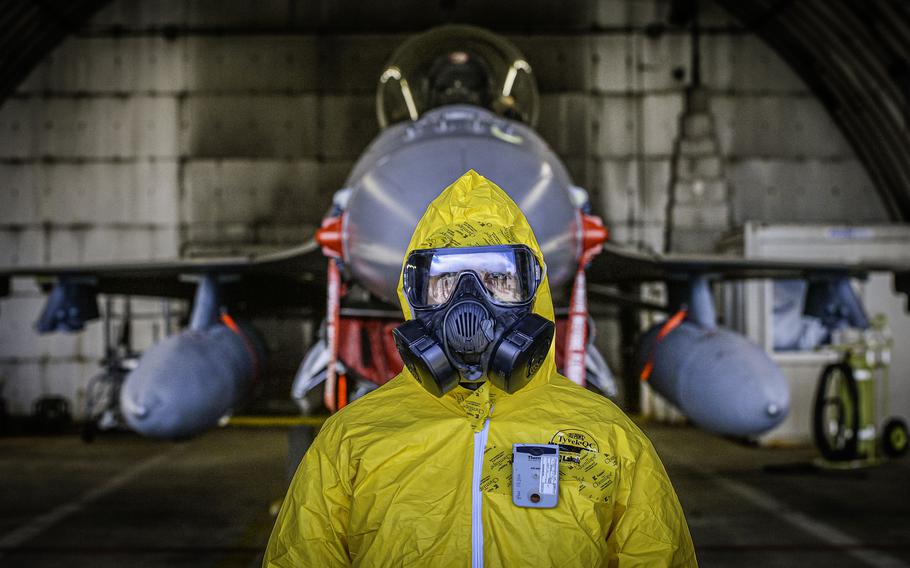
Tech. Sgt. Kayla Bradford waits for a radiological assessment on an F-16 Fighting Falcon during exercise Radiant Falcon, held April 24, 2024, at Spangdahlem Air Base, Germany. She is wearing a device that monitors gamma and beta radiation exposure in real time and alerts the user to unsafe exposure levels. (Alexander Riedel/Stars and Stripes)
SPANGDAHLEM AIR BASE, Germany — Airmen at this F-16 fighter wing installation in rural southwestern Germany are learning how to safely receive and relaunch an aircraft exposed to nuclear radiation.
Held over three days this week and led by American instructors, Radiant Falcon was the first exercise of its kind held at Spangdahlem.
Classroom lessons on Tuesday were followed by a dress rehearsal Wednesday. Airmen were covered from head to toe in yellow protective suits, rubber boots, gloves and a gas mask.
The airplane has been exposed to some type of radiation and is returning to a deployed location, Staff Sgt. Donel Wanton, a bioenvironmental engineer for the 52nd Fighter Wing, said in summarizing the exercise scenario.
The response involved more than 30 airmen from various career fields, including emergency responders, medical personnel, refuelers, aircraft equipment handlers, weapons crews and maintainers.
The array of specialties showed the Air Force’s emphasis on having airmen be able to quickly deploy in small groups and do multiple jobs, Spangdahlem officials said.
Electronic personal dosimeters, about the size of a credit card, were clipped to their suits to monitor individual radiation exposure, and other tools detected the level of radioactive particles in the air and on the aircraft.
The job is to check the pilot, ensure that the airmen recovering the aircraft are protected and decontaminate the plane, Wanton said.
Airmen began putting on the suits when they were told the plane was about 20 minutes out. Some imagination was required, as the F-16 was already parked next to them inside a hardened aircraft shell.
Under the scenario, adversaries had used tactical nuclear weapons against allies. A counterstrike mission may have flown through radioactive material, explained Joe Potaczek, one of two instructors from Alliance Solutions Group in Newport News, Va.
“The idea is ‘How does the Air Force continue the mission?’” he said. “How do we keep the aircraft flying and keep the people safe at the same time?”
The exercise wasn’t tied to current events in Europe or elsewhere, Spangdahlem officials said.
And as Wanton pointed out, the training can apply to a variety of situations, such as radiation exposure from a nuclear plant accident, like the one in Fukushima, Japan, following the 2011 earthquake and tsunami.
Potaczek’s organization has conducted similar exercises with mobility and fighter units in the United States, particularly with Air Mobility Command and Air Combat Command.
But the training is relatively new in Europe. U.S. Air Forces in Europe – Air Forces Africa’s first Radiant Falcon was held a year ago at Ramstein, officials said.
The company’s instructors have also been to Aviano Air Base in Italy and plan to conduct similar training at England’s RAF Lakenheath next month, Potaczek said.
For the Spangdahlem exercise, airmen entered data into an Excel spreadsheet and calculated hypothetical radiation exposure. That information allows commanders to gauge risks, Wanton said.
With gas masks on, airmen learned how to communicate with hand signals, such as tapping on their head if they felt ill.
Maintainers had to carefully inspect the plane’s air intake, looking for nicks or dents on the engine blades, said Tech. Sgt. Kayla Bradford, a phase dock inspection chief at Spangdahlem.
“That would mean that something got sucked up in there” that could be contaminated, such as a bird, sand or rocks, she said, adding that such damage might indicate that the plane needs a new engine.
The exercise was scheduled to wrap up Thursday with a review of lessons learned, all centered around figuring out “what’s going on with the aircraft and (getting) it back into the air as soon as possible,” Wanton said.